|
|
 |
Fiche d'espèce de Copépode |
|
|
Calanoida ( Ordre ) |
|
|
|
Diaptomoidea ( Superfamille ) |
|
|
|
Pontellidae ( Famille ) |
|
|
|
Calanopia ( Genre ) |
|
|
| |
Calanopia elliptica (Dana, 1849) (F,M) | |
| | | | | | | Syn.: | Pontella elliptica Dana,1849;
Calanopia sp. Pesta, 1912 a (p.52, fig. juv.);
No Calanopia elliptica : Wilson, 1942 a (part., p.172, fig.F) | | | | Ref.: | | | Brady, 1883 (p.85, figs.F,M); Giesbrecht, 1892 (p.441, 770, figs.M); 1896 (1897) (p.325, figs.F); Giesbrecht & Schmeil, 1898 (p.132, Rem. F,M); Thompson & Scott, 1903 (p.235, 251); A. Scott, 1909 (p.176, figs.F,M); Pesta, 1912 a (p.50, figs.F); 1913 (p.32); Sewell, 1914 a (p.231); Gurney, 1927 (p.154, figs.F,M, Rem.); Sewell, 1932 (p.341); Farran, 1936 a (p.115); Mori, 1937 (1964) (p.89, figs.F,M); Dakin & Colefax, 1940 (p.105, figs.F,M); Sewell, 1947 (p.248); Chiba & al., 1957 (p.308); Bowman, 1957 (p.39, Rem.); Kasturirangan, 1963 (p.47, 48, figs.F,M); Tanaka, 1964 c (p.250, Rem.F,M); Chen & Zhang, 1965 (p.95, figs.F,M); Saraswathy, 1966 (1967) (p.85); Silas & Pillai, 1976 (p.785, figs.F,M, Rem.); Greenwood, 1979 (p.93, 94, Rem.); Lakkis, 1984 (p.299, figs.M); Bundy & Paffenhöfer, 1993 (p.3, figs.F); Chihara & Murano, 1997 (p.865, Pl.146: F,M); Bradford-Grieve & al., 1999 (p.885, 958, figs.F,M); Bradford-Grieve, 1999 b (p.185, figs.F,M, figs.184, 194); Mulyadi, 2002 (p.41, figs.F,M, Rem.); Al-Yamani & Prusova, 2003 (p.77, figs.F,M); Conway & al., 2003 (p.121, figs.F,M, Rem.); Othman & Toda, 2006 (p.307, F,M); Vives & Shmeleva, 2007 (p.490, figs.F,M, Rem.); Phukham, 2008 (p.74, figs.F,M); Al-Yamani & al., 2011 (p.58, figs.F,M)
| 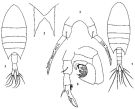 issued from: Q.-c. Chen & S.-z. Zhang in Studia Marina Sinica, 1965, 7. [Pl.39, 1-5]. Female (from E China Sea): 1, habitus (dorsal); 2, rostrum (ventral view); 3, P5 (posterior). Male: 4, habitus (dorsal); 5, P5 (posterior).
|
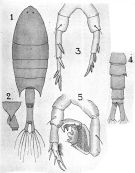 issued from : A. Scott in Siboga-Expedition, 1909, XIX a. [Plate XLVIII, Figs.1-5]. Female (from Indonesia-Malaysia): 1, habitus (dorsal); 2, last thoracic and genital segments (left side); 3, P5. Male: urosome (dorsal); 5, P5.
|
 issued from : E.G. Silas & P.P. Pillai in J. mar. biol. Ass. India, 1973 (1976), 15 (2). [p.786, Fig.3]. Female (from Indian Ocean): a, urosome (dorsal); b, rostrum (anterior view); c, P5. Male: d, urosome (dorsal); e, right A1 (geniculate); f, P5. Scale as in Calanopia minor.
|
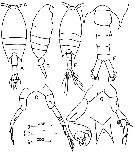 issued from : F.Y. Al-Yamani & I. Prusova in Common Copepods Northwestern Arabian Gulf : Identification Guide. Kuwait Institute for Scientific Research, 2003. [p.77, Fig.27]. Female: A, habitus (dorsal); B, idem (lateral right side); C, P5; D, rostrum. Male: E, habitus (dorsal); F, urosome (dorsal); G, P5.
|
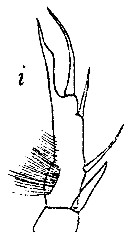 issued from T.E. Bowman in Proc. U.S. Nat. Mus., 1957, 107 (3382). [p.43, Fig.3, i]. Male: distal segment of left P5.
|
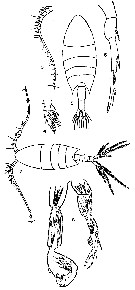 issued from : T. Mori in The pelagic Copepoda from the neighbouring waters of Japan, 1937 (2nd edit., 1964). [Pl.40, Figs.3-8]. Female: 3, A1; 4, P1: 5, habitus (dorsal); 6, P5. Male: 7, habitus (dorsal); 8, P5.
|
 issued from : W. Giesbrecht in Zool. Jahrb., 1896 (1897). [Taf.5, Figs.7-9]. Female (from Red Sea): 7, A1; 8, P5; 9, urosome (ventral).
|
 Issued from : W. Giesbrecht in Systematik und Faunistik der Pelagischen Copepoden des Golfes von Neapel und der angrenzenden Meeres-Abschnitte. - Fauna Flora Golf. Neapel, 1892. Atlas von 54 Tafeln. [Taf.31 , Figs.23-26 ]. Male: 23, Mx1 (posterior view); 24, A2 (anterior view); 25, Mxp (posterior view); 26, right A1.
|
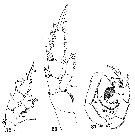 Issued from : W. Giesbrecht in Systematik und Faunistik der Pelagischen Copepoden des Golfes von Neapel und der angrenzenden Meeres-Abschnitte. - Fauna Flora Golf. Neapel, 1892. Atlas von 54 Tafeln. [Taf.31 , Figs.21, 31-32 ]. Male: 21, P4 (anterior view); 31, P5 (posterior view); 32, P1 (posterior view).
|
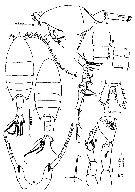 issued from : Mulyadi in Treubia, 2002, 32; [p.43, Fig.11]. Female (from Indonesian waters): a, habitus (dorsal); b, forehead (lateral); c, metasomal somite 5 and urosome (lateral); d, anal somite and caudal rami (dorsal); e, P5. Male: f, habitus (dorsal); g-h, genital somite and urosomal somite 2 (dorsal and lateral, respectively); i, right A1; j, right P5; k, left P5.
|
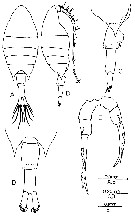 issued from : B.H.R. Othman & T. Toda in Coastal Mar. Sc., 2006, 30 (1). [p.307, Fig.3]. Female (from Sister's Island, Singapore): A-B, habitus (dorsal and lateral, respectively); C-D, posterior part of prosome and urosome (lateral and dorsal, respectively); E, P5. Nota Female: Prosome to urosome length ratio 2.29 : 1. - Cephalon without lateral hook. - Thoracic segment produced posteriorly into strong process reaching middle genital segment. - Urosome 2-segmented. - Genital segment same in length as urosomites 2. - P5 asymmetrical, left leg longer than right. Exopodal segment 1 with 1 median and 1 distolateral spine; exopodal segment 2 ending in an acute spine with 2 outer marginal spine.
Nota Male: Prosome to urosome length ratio 2.35 : 1.
- Body similar to female except the right thoracic process is longer than left and pointed inwards.
- Right A1 geniculate, segments 13-16 swollen while segments 19-21 denticulate.. A1 extends to the genital segment.
- Urosome 5-segmented; urosomite 2 with 1 spiniform process on distal right margin.
- P5 asymmetrical; right leg exopodal segment 1 modified as chela, with 3 inner marginal process blunt and tooth-like; exopodal segment 2 with 3 processes along the inner margin; left leg, exopodal segment 1 with 2 outer marginal spines, 1 at mid-outer margin and another distolaterally; exopodal segment 2 with 2 outer marginal spines and terminates in a strong acute spine with setules on the outer margin.
|
 issued from : B.H.R. Othman & T. Toda in Coastal Mar. Sc., 2006, 30 (1). [p.308, Fig.4]. Male (from Sister's Island, Singapore): A-B, habitus (dorsal and lateral, respectively); C-D, posterior part of prosome and urosome (dorsal and lateral, respectively); E, P5.
|
 issued from : Y. Al-Yamani, V. Skryabin, A. Gubanova, S. khvorov & I. Prusova in Marine Zooplankton Practical Guide for the Northwestern Arabian Gulf, 2, 2011. [p.59, Fig.184]. Male (from Kuwait): habitus (dorsal). Arrow indicates the tooth on the urosome.
|
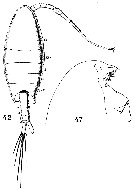 Issued from : W. Giesbrecht in Systematik und Faunistik der Pelagischen Copepoden des Golfes von Neapel und der angrenzenden Meeres-Abschnitte. – Fauna Flora Golf. Neapel, 1892. Atlas von 54 Tafeln. [Taf.38 , Figs.42, 47 ]. Male: 42, habitus (dorsal); 47, forehead (lateral).
|
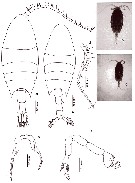 issued from : N. Phukham in Species diversity of calanoid copepods in Thai waters, Andaman Sea (Master of Science, Univ. Bangkok). 2008. [p.156, Fig.30]. Female (from W Malay Peninsula): a, habitus (dorsal); b, P5. Male: c, habitus (dorsal); d, A1; e, P5. Body length after the drawings: F = 1.712 mm; M = 1.700 mm.
|
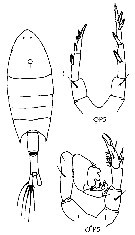 Issued from : J.M. Bradford-Grieve, E.L. Markhaseva, C.E.F. Rocha & B. Abiahy in South Atlantic Zooplankton, edit. D. Boltovskoy. 1999, Vol. 2, Copepoda; [p.1067, Fig. 7.379: Calanopia elliptica]. r = right leg; l = left leg. Female characters (p.958): - P5 female with 2 segments distal to basis. Male characters (from key, p.958): - 'Thumb' on right P5 exopodal segment1-2 rudimentary or absent.
|
 Calanopia elliptica Calanopia elliptica. Female: 1 - P5 exopod 2-segmented. 2 - Cephalic lateral hooks absent. 3 - P5 asymmetrical, left one longer. Male: 1 - Left P5 shorter than right one; basis of left P5 ,not swollen proximally. 2 - Prosomal posterolateral corner symmetrical. 3 - Cephalic lateral hooks absent. 4 - 2nd urosomite asymmetrical with 1 process on right side. 5 - 2nd urosomite with 1 aculinate-tip spinose process postero-laterally on right side; P5 left leg relatively long reaching beyond distal end of 1st exopodal segment of right leg.
|
 Issued from : R. Gurney in Trans. zool. Soc. London, 1927, 22. [p.155, Fig.21]. Female (Port Taufik): A, genital double-somite and P5 (ventral); B, terminal segments of P5. Male (Port Taufik): C, P5; D, abdomen (ventral).
|
 Issued from : R. Gurney in Trans. zool. Soc. London, 1927, 22. [p.154]. Relative lengths of cephalothorax, abdomen and caudal rami; and the genital double-somite and the 2nd abdominal somite. Comparison between Calanopia media, C. elliptica and C. minor females.
| | | | | Ref. compl.: | | | Carl, 1907 (p.17); Sewell, 1912 (p.353, 368); 1948 (p.325, 434); C.B. Wilson, 1950 (p.175); Krishnaswamy, 1953 (p.138); Kott, 1957 (p.6, 18); Yamazi, 1958 (p.151, Rem.); Ganapati & Shanthakumari, 1962 (p.9, 15); Berdugo, 1963 (p.445: Rem.); De Decker & Mombeck, 1964 (p.11); Delalo, 1968 (p.138); Berdugo, 1968 (p.445); Brodsky, 1972 (p.256); Lakkis, 1976 (p.83: Rem.); Sale P.F. & al., 1976 (p.59, table 3); Carter, 1977 (1978) (p.36); Ikeda, 1977 d (p.263, feeding); Grice & Gibson, 1978 (p.23, tab.8); Chen Q-c, 1980 (p.794); Skjoldal, 1981 (p.119, adenylate energy); Sreekmaran Nair & al., 1981 (p.493, Fig.2 cont.); Kovalev & Shmeleva, 1982 (p.85); De Decker, 1984 (p.317); Binet, 1984 (tab.3); 1985 (p.85, tab.3); Moraitou-Apostolopoulou, 1985 (p.303, occurrence/abundance in E Mediterranean Sea, Rem.: p.313); Madhupratap & Haridas, 1986 (p.105, tab.1); Williams D. & al., 1988 (p.580); Lakkis, 1990 (p.63); Othman & al., 1990 (p.561, 564, Table 1); Madhupratap & Haridas, 1990 (p.305, fig.4: vertical distribution night/day; fig.7: cluster); Yoo, 1991 (tab.1); Dai & al., 1991 (tab.1); Shih & Young, 1995 (p.71); Park & Choi, 1997 (Appendix); Sharaf & Al-Ghais, 1997 (tab.1); Mauchline, 1998 (tab.8,78); Achuthankutty & al., 1998 (p.1, Table 2, seasonal abundance vs monsoon); Hsieh & Chiu, 1998 (tab.2); Hwang & al., 1998 (tab.II); Wong & al., 1998 (tab.2); El-Serehy, 1999 (p.172, Table 1, occurrence); Lo & al., 2001 (1139, tab.I); Greenwood & al., 2002 (p.17, Table 2); Osore & al., 2003 (p.69); Hwang & al., 2003 (p.193, tab.2); Shimode & Shirayama, 2004 (p.607, tab.1, 2); Hsiao & al., 2004 (p.326, tab.1); Rezai & al., 2004 (p.489, tab.2); Lan & al., 2004 (p.332, tab.1, tab.2); Lo & al.*, 2004 (p.218, tab.1, fig.6); Satapoomin & al., 2004 (p.107, tab.4); Lo & al., 2004 (p.89, tab.1); Kazmi, 2004 (p.228, as elleptica); Rezai & al., 2005 (p.157, Table 5: spatial & temporal variations); Lakkis & al., 2005 (p.152); Obuid Allah & al., 2005 (p.123, occurrence % vs metal contamination); Zuo & al., 2006 (p.163: tab.1); Rakhesh & al., 2006 (p.93, Table 2, spatial distribution); Hwang & al., 2006 (p.943, tabl. I); Kovalev, 2006 (p.67: Lessepsian migration); Hwang & al., 2007 (p.24); Dur & al., 2007 (p.197, Table IV); Rakhesh & al., 2008 (p.154, abundance vs stations); Fernandes, 2008 (p.465, Tabl.2); Tseng L.-C. & al., 2008 (p.153, Table 2, occurrence vs geographic distribution); Tseng & al., 2008 (p.402, Table 2); Tseng L.-C. & al., 2008 (p.46, table 2, abundance vs moonsons, fig.8); Pagano, 2009 (p.115); C.-Y. Lee & al., 2009 (p.151, Tab.2); Tseng & al., 2009 (p.327, fig.5, feeding); Cornils & al., 2010 (p.2076, Table 3); Zenetos & al., 2010 (p.397); W.-B. Chang & al., 2010 (p.735, Table 2, abundance); Shanthi & Ramanibai, 2011 (p.132, Table 1); Hsiao S.H. & al., 2011 (p.475, Appendix I); Kâ & Hwang, 2011 (p.155, Table 3: occurrence %); Tseng L.-C. & al., 2011 (p.47, Table 2, occurrences vs mesh sizes); Maiphae & Sa-ardrit, 2011 (p.641, Table 2, 3, Rem.); Uysal & Shmeleva, 2012 (p.909, Table I); Tseng & al., 2012 (p.621, Table 3: abundance); Tseng & al., 2013 (p.507, seasonal abundance); Jagadeesan & al., 2013 (p.27, Table 3, seasonal abundance); Rakhesh & al., 2013 (p.7, Table 1, abundance vs stations); Terbiyik Kurt & Polat, 2013 (p.1163, Table 2, fig.9, seasonal distribution); Hwang & al., 2014 (p.43, Appendix A: seasonal abundance); Beltran Castro, 2014 (p.33, Table 1, 2: molecular CO1); Nakajima & al., 2015 (p.19, Table 3: abundance); Benedetti & al., 2016 (p.159, Table I, fig.1, functional characters); Palomares-Garcia & al., 2018 (p.178, Table 1: occurrence); Belmonte, 2018 (p.273, Table I: Italian zones) | | | | NZ: | 11 | | |
|
Carte de distribution de Calanopia elliptica par zones géographiques
|
| | | | | | | | | | | |  Issued from : M. Madhupratap & P. Haridas in J. Plankton Res., 12 (2). [p.311, Fig.4]. Issued from : M. Madhupratap & P. Haridas in J. Plankton Res., 12 (2). [p.311, Fig.4].
Vertical distribution of calanoid copepod (mean +1 SE), abundance No/100 m3. 31- Calanopia elliptica.
Night: shaded, day: unshaded.
Samples collected from 6 stations located off Cochin (India), SE Arabian Sea, November 1983, with a Multiple Closing Plankton Net (mesh aperture 300 µm), in vertical hauls at 4 depth intervalls (0-200, 200-400, 400-600, 600-1000 m). |
| | | | Loc: | | | South Africa (E), [non G. of Mexico (in C.B. Wilson, 1942 a, p.172; 1950, p.175: st.2396), Bermuda (in Wilson, 1936 c)], Georgia, Mediterranen Sea (Napoli, Iskenderun Bay, N Lebanon Basin, Lebanon, off Haifa), Suez Canal, Port Taufik, Kabret, Red Sea, G. of Aden, Arabian (south coast), Arabian Sea, Arabian Gulf, UAE coast, Kuwait, Maldive Is., Laccadive Is., Sri Lanka, Natal, Madagascar (Nosy Bé), Indian, India (Goa, G. of Mannar, Palk Bay, Madras, Lawson's Bay), E India (Kakinada Bay, Godavari region) Bay of Bengal, Is. Nicobar, W Malay Peninsula, off Phuket, Nankauri Harbour, Straits of Malacca, Singapore, G of Thaïland, Indonesia (Bangka Strait, Sunda Strait, Jakarta Bay, Cilacap Bay, N Java coast, SE Ceram, Ambon Bay, Tioman Is., SW Celebes), Philippines, Viet-Nam (Cauda Bay), Gulf of Tonkin, Hong Kong, China Seas (Yellow Sea, East China Sea, South China Sea, Xiamen Harbour), Taiwan (S, E, SW, NW, N, NE, Mienhua Canyon), S Korea, Japan (Tanabe Bay), Australia (G. of Carpentaria, SE, Great Barrier, Townsville: inshore waters, Brisbane River estuary, Moreton Bay), New Caledonia, Is. Fidji Is., Gilbert Is., Samoa Is., Clipperton Is., G. of California, Bahia de La Paz, Islas Marias.
Type locality: Bangka Strait (northeastern Sumatra) | | | | N: | 135 (Atlant. S: 1; Medit.: 2; Red Sea: 8; Indian: 37; Indonesia-Malaysia: 7; Pacif.: 81) | | | | Lg.: | | | (5) F: 1,9; M: 1,8; (34) F: 1,97-1,75; M: 1,8-1,6; (46) M: 1,65; (47) F: 2-1,55; (104) F: 1,7; M: 1,9; (120) F: 1,86; M: 1,84; (256) F: 1,78-1,69; M: 1,71-1,62; (290) F: 1,75-1,8; M: 1,6-1,7; (334) F: 1,9; M: 1,8; (530) F: 1,8; M: 1,5; (795) F: 1,9; M: 1,6; (937) F: 1,83-1,90; M: 1,73-1,76; (991) F: 1,7-2; M: 1,8-1,9; (1085) F: 1,6-1,9; M: 1,4-1,8; (1086) F: 1,67-2,10; M: 1,62-1,71; (1087) F: 1,65-1,75; M: 1,6-1,75; {F: 1,55-2,10; M: 1,40-1,90} | | | | Rem.: | épipélagique.
Les localisations données par C.B. Wilson (1942 a; 1950) en atlantique sont considérées comme éronnées, mais Bundy & Paffenhöfer (1993) confirme la présence de l'espèce off Géorgie.
La pénétration de cette espèce en Méditerranée E (Haïfa, Liban, Turquie: Iskenderoun Bay) serait due au Canal de Suez (Lessepsian migration) d'après Berdugo (1968).
Vives & Shmeleva (2007, p.491) signalent cette espèce à Naples.
Voir aussi les remarques en anglais | | | Dernière mise à jour : 03/12/2020 | |
|
|
 Toute utilisation de ce site pour une publication sera mentionnée avec la référence suivante : Toute utilisation de ce site pour une publication sera mentionnée avec la référence suivante :
Razouls C., Desreumaux N., Kouwenberg J. et de Bovée F., 2005-2025. - Biodiversité des Copépodes planctoniques marins (morphologie, répartition géographique et données biologiques). Sorbonne Université, CNRS. Disponible sur http://copepodes.obs-banyuls.fr [Accédé le 23 octobre 2025] © copyright 2005-2025 Sorbonne Université, CNRS
|
|
 |
 |



















